Monaco
5-9 February 2007
Les Saintes-Maries- de-la-Mer and Palavas-les-Flots were small, quiet towns in an incredibly flat environment. Monaco and the surrounding area (Roquebrune and Menton) are big, often noisy cities that dip their toes in the Mediterranean and rest their heads on the 1500 meter mountains rising steeply from the sea. Access by land (road or rail) involves long tunnels (up to 1.5 km) and viaducts; ; the nearest airport is in Nice where landfill of the Med permits runways; each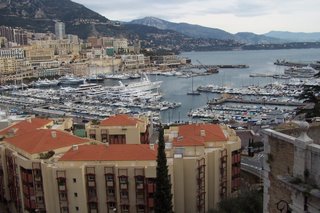 of the three cities has a relatively small port, although Monaco has one pier to accommodate smaller cruise ships.
of the three cities has a relatively small port, although Monaco has one pier to accommodate smaller cruise ships.
The principality of Monaco is surrounded by France (Roquebrune to the north (above) and east and Eze to the west and south). For its growth it depends on adding more high rise buildings with large underground parking facilities; and on claiming land from the Mediterranean. Space is at such a premium that there are no above ground parking lots. But there are a number of underground lots (free parking for the first hour), and in early February there was no problem finding space.
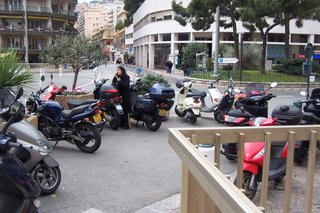 The ubiquitous Vespa (although today most scooters are made by Honda), in the foregound, is a common mode of transportation in and around Monaco and for them there are mini above ground parking lots.
The ubiquitous Vespa (although today most scooters are made by Honda), in the foregound, is a common mode of transportation in and around Monaco and for them there are mini above ground parking lots.
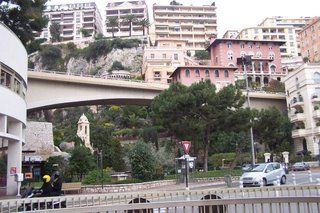
While these make driving interesting, the worst for poor or reckless driving skills, noise, and pollution are the two cycle gas powered mini-motorcycles. Having these pass your motor home at night are like swarms of mosquitoes that can’t be beaten off with insect repellent or fly swatters.
Motor homes are not welcomed in this area. We can imagine the traffic problems they could cause in the busy summer tourist season. There are very few places that they can even park let alone stay overnight. On the Menton/Roquebrune border they can set up for 72 hours in a string of about 30 parking spaces on the side of the road on one side the Parc de la Madona; a few more spaces about 1.5 km past downtown Menton on the waterfront; and 5 spaces at the Roquebrune-Cap Martin railway station.
Whether staying in a hotel or in a motor home the best ways to get around are by train and by foot. The trains run frequently along the coast about 200-300 meters above sea level and when they‘re not running through tunnels have excellent views of the homes, apartments and hotels clinging to the mountains above and below the train and of the Mediterranean. Bicycles are not a practical mode of transportation, except along some segments of the waterfront. For the strong of heart, the very fit and the fearless, bicycles can be used anywhere. But beware – these are narrow, winding, often steep roads and the controlling speed limit is usually 70 km/hour. While you might be able to do 60 km/hour, or more, downhill the two stroke mosquito scooters will be fighting with you for the right hand side of the road and cars will often be doing 80 or 90 km/hour. Of course uphill you will be doing much less and blocking traffic that will be doing its best to pass you.
The beaches are much better away from the French Riviera and everything is significantly less expensive.
So with all of these negatives, why come here.
Despite the negatives, this is a dramatically beautiful place, especially Monaco. The trains make getting around very easy and you can stay some distance away from Monaco in less expensive areas and get there within 30 minutes. There is a certain magical lore about Monaco, and the Grimaldis do their best to maintain this. The Late Prince Rainier III, his fairy tale wedding to Hollywood film star Grace Kelly, the Grand Prix de Monaco, the Casino (think James Bond as 007 and the croupiers cry - rien ne va plus, faītes vos jeux), the palace and cathedral all contribute.
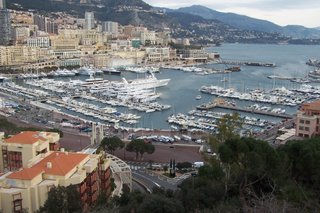 And the Rock itself, rising majestically from the sea and pinned against the mountains, gives pause for reflection.
And the Rock itself, rising majestically from the sea and pinned against the mountains, gives pause for reflection.
 To access the Rock by foot we follow the sidewalk and steps leading through 3 or 4 switchbacks and 3 gates
To access the Rock by foot we follow the sidewalk and steps leading through 3 or 4 switchbacks and 3 gates
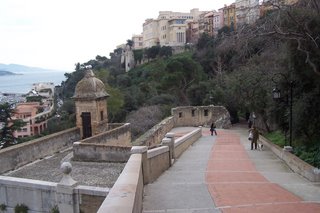
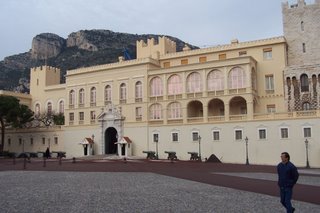 to the square in front of the palace,
to the square in front of the palace,
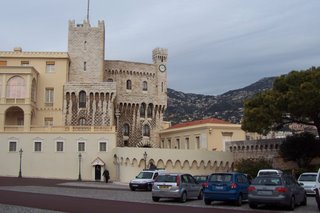
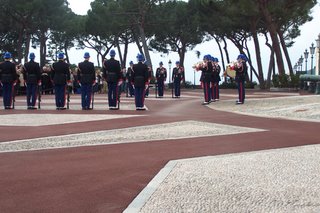
 and its noon hour changing of the guard, here in their winter uniforms.
and its noon hour changing of the guard, here in their winter uniforms.
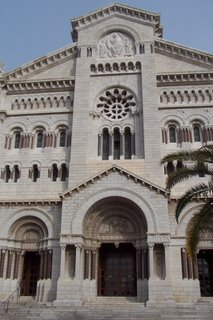 The cathedral was built between 1875 and 1884 over the former church of Saint Nicholas (the patron saint of sailors and school children).
The cathedral was built between 1875 and 1884 over the former church of Saint Nicholas (the patron saint of sailors and school children).
While not very old by European standards, the neo-romanesque style Cathedral is beautiful inside and out.
 Many citizens of Monaco (les Monégasques) look forward to a state wedding and the society photos on these steps for Hello and Paris Match magazines and nine months later the baptism of a male heir in this cathedral provided the 48 year old Prince Albert gets his act together, gives up the joys of bachelorhood and accepts the compromises of marriage and fatherhood.
Many citizens of Monaco (les Monégasques) look forward to a state wedding and the society photos on these steps for Hello and Paris Match magazines and nine months later the baptism of a male heir in this cathedral provided the 48 year old Prince Albert gets his act together, gives up the joys of bachelorhood and accepts the compromises of marriage and fatherhood.
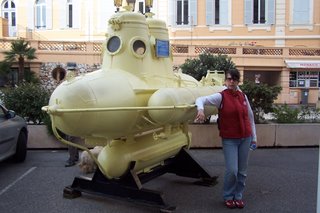 The Rock boasts a good museum of oceanography that can be identified by the mermaids clinging to the mini-submarine,
The Rock boasts a good museum of oceanography that can be identified by the mermaids clinging to the mini-submarine,
or by its dramatic cliff-top architecture.
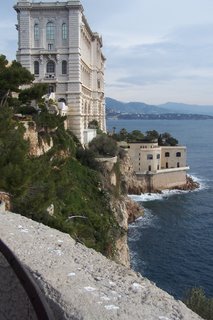
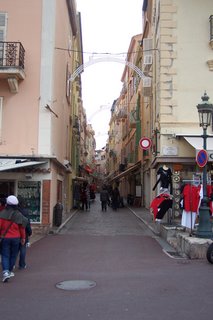 Three streets radiate from one side of the palace square and provide lots of opportunity for pedestrians: restaurants, shopping, museums, gardens.
Three streets radiate from one side of the palace square and provide lots of opportunity for pedestrians: restaurants, shopping, museums, gardens.
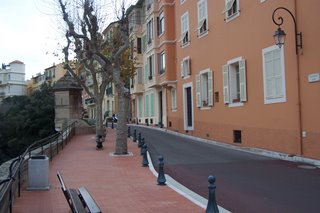
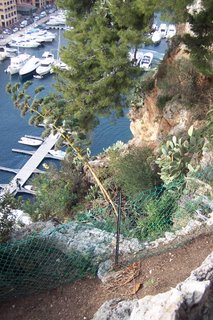 Another side of the square leads to a series of paths overlooking one of the 6 districts of Monaco. Fontvielle is built in part on land recently claimed from the sea through landfill.
Another side of the square leads to a series of paths overlooking one of the 6 districts of Monaco. Fontvielle is built in part on land recently claimed from the sea through landfill.
 This perspective illustrates the height of the Rock, the natural defences of its topography and the flat land claimed from the sea.
This perspective illustrates the height of the Rock, the natural defences of its topography and the flat land claimed from the sea.
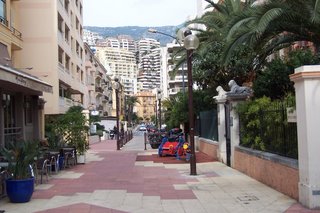 The Monte Carlo district includes part of downtown Monaco, the principal port,
The Monte Carlo district includes part of downtown Monaco, the principal port,
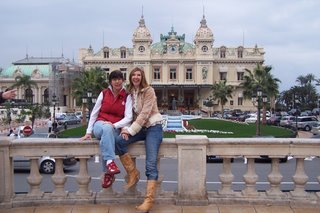
the Casino (1863), behind Marie-Claire and her beautiful 35 year-old niece (in search of one good man – for a permanent relationship, otherwise known as marriage). Now let‘s see – there‘s a 48 year old bachelor prince living just down the hill from her …
 The elegant Hôtel de Paris (1864) is on the square with the Casino and if you can afford it a great place to park yourself for a week.
The elegant Hôtel de Paris (1864) is on the square with the Casino and if you can afford it a great place to park yourself for a week.
If shopping is your game, forget the Casino and walk a few steps to the incredible mall, Le Metropole,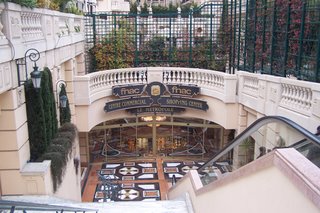
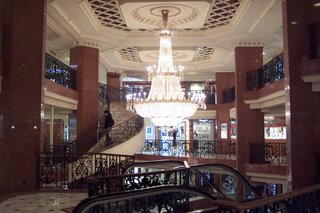 Yes the chandelier is in a mall, and it is located under the equally incredible Hôtel Metropole.
Yes the chandelier is in a mall, and it is located under the equally incredible Hôtel Metropole.
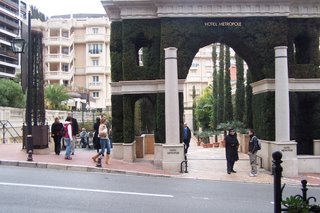
If you still have not seen enough ways to spend your money there are a number of museums (fine arts, dolls, wax, cars etc.), golf at 800 meters, an exotic garden and grotto, zoo, BIG boats to charter, Ferrari and Lamborghini dealerships, and so and so on…
Apart from the Grand Prix de Monaco, cars do not seem as intrusive as in neighbouring Roquebrune and Menton and the horrible little two-wheeled mosquitoes seem to hit an invisible barrier at the border of Monaco making it a much more pleasant place to walk.
So whether you want to spend a little money (take the train) or a lot (take the helicopter), Monaco is a great place to visit – and if you have lots of money an interesting place to live.
A Little History
Originally a port controlled in succession by the Phoenicians, Greeks, Carthaginians, Marsis and Romans, Monaco in the 12th century was placed under Genoese sovereignty by Henry VI, Emperor and King of Germany. Genoa, then an independent republic is located across the gulf in modern day northern Italy. In 1295 the powerful Genoese family, the Grimaldis, having been on the wrong side of a political dispute in Genoa were exiled to Provence. In 1297, Francesco Grimaldi, known as ‘Malizia‘ or malicious – disguised himself as a monk to gain entrance to the fortress, opened the gates and let his soldiers in to capture the Rock. In a scant 4 years (1301) the Grimaldis were forced to return its control to the Republic of Genoa. Eventually Charles I, considered the true fonder of the House of Monaco led the Grimaldis to a more or less permanent rule of the area. Charles I extended his area of control by buying sovereignty over neighbouring Roquebrune and Menton. In 1524 Monaco came under Spanish Protection and a century later (1633) Spain recognized Honoré II as Prince of Monaco. The Treaty of Peronne (1641) assured the Principality the friendship and protection of France. But a century later (1793) Monaco was annexed by France and rechristened Port d‘Hercule. 21 years later Prince Honoré V was restored to the throne of Monaco. On 5 January 1911, Albert I agreed to Monaco‘s first constitution. He was succeeded by Louis II, under whose reign the Grand Prix was launched in 1929. Prince Rainier III, his grandson, came to the throne in 1949 and began the development of Monaco as a modern state. Married to film star Grace Kelly in 1956, Rainier fathered a daughter (Caroline 1957), a son (Albert 1959) and a second daughter (Stephanie 1965). Princess Grace of Monaco died in a car crash (Stephanie was at the wheel) in 1982. Rainier died in 2005 at the age of 81 bringing Crown Prince Albert to the throne. And the rest is the future.
Les Saintes-Maries- de-la-Mer and Palavas-les-Flots were small, quiet towns in an incredibly flat environment. Monaco and the surrounding area (Roquebrune and Menton) are big, often noisy cities that dip their toes in the Mediterranean and rest their heads on the 1500 meter mountains rising steeply from the sea. Access by land (road or rail) involves long tunnels (up to 1.5 km) and viaducts; ; the nearest airport is in Nice where landfill of the Med permits runways; each
 of the three cities has a relatively small port, although Monaco has one pier to accommodate smaller cruise ships.
of the three cities has a relatively small port, although Monaco has one pier to accommodate smaller cruise ships.The principality of Monaco is surrounded by France (Roquebrune to the north (above) and east and Eze to the west and south). For its growth it depends on adding more high rise buildings with large underground parking facilities; and on claiming land from the Mediterranean. Space is at such a premium that there are no above ground parking lots. But there are a number of underground lots (free parking for the first hour), and in early February there was no problem finding space.
 The ubiquitous Vespa (although today most scooters are made by Honda), in the foregound, is a common mode of transportation in and around Monaco and for them there are mini above ground parking lots.
The ubiquitous Vespa (although today most scooters are made by Honda), in the foregound, is a common mode of transportation in and around Monaco and for them there are mini above ground parking lots.
While these make driving interesting, the worst for poor or reckless driving skills, noise, and pollution are the two cycle gas powered mini-motorcycles. Having these pass your motor home at night are like swarms of mosquitoes that can’t be beaten off with insect repellent or fly swatters.
Motor homes are not welcomed in this area. We can imagine the traffic problems they could cause in the busy summer tourist season. There are very few places that they can even park let alone stay overnight. On the Menton/Roquebrune border they can set up for 72 hours in a string of about 30 parking spaces on the side of the road on one side the Parc de la Madona; a few more spaces about 1.5 km past downtown Menton on the waterfront; and 5 spaces at the Roquebrune-Cap Martin railway station.
Whether staying in a hotel or in a motor home the best ways to get around are by train and by foot. The trains run frequently along the coast about 200-300 meters above sea level and when they‘re not running through tunnels have excellent views of the homes, apartments and hotels clinging to the mountains above and below the train and of the Mediterranean. Bicycles are not a practical mode of transportation, except along some segments of the waterfront. For the strong of heart, the very fit and the fearless, bicycles can be used anywhere. But beware – these are narrow, winding, often steep roads and the controlling speed limit is usually 70 km/hour. While you might be able to do 60 km/hour, or more, downhill the two stroke mosquito scooters will be fighting with you for the right hand side of the road and cars will often be doing 80 or 90 km/hour. Of course uphill you will be doing much less and blocking traffic that will be doing its best to pass you.
The beaches are much better away from the French Riviera and everything is significantly less expensive.
So with all of these negatives, why come here.
Despite the negatives, this is a dramatically beautiful place, especially Monaco. The trains make getting around very easy and you can stay some distance away from Monaco in less expensive areas and get there within 30 minutes. There is a certain magical lore about Monaco, and the Grimaldis do their best to maintain this. The Late Prince Rainier III, his fairy tale wedding to Hollywood film star Grace Kelly, the Grand Prix de Monaco, the Casino (think James Bond as 007 and the croupiers cry - rien ne va plus, faītes vos jeux), the palace and cathedral all contribute.
 And the Rock itself, rising majestically from the sea and pinned against the mountains, gives pause for reflection.
And the Rock itself, rising majestically from the sea and pinned against the mountains, gives pause for reflection. To access the Rock by foot we follow the sidewalk and steps leading through 3 or 4 switchbacks and 3 gates
To access the Rock by foot we follow the sidewalk and steps leading through 3 or 4 switchbacks and 3 gates
 to the square in front of the palace,
to the square in front of the palace,

 and its noon hour changing of the guard, here in their winter uniforms.
and its noon hour changing of the guard, here in their winter uniforms. The cathedral was built between 1875 and 1884 over the former church of Saint Nicholas (the patron saint of sailors and school children).
The cathedral was built between 1875 and 1884 over the former church of Saint Nicholas (the patron saint of sailors and school children).While not very old by European standards, the neo-romanesque style Cathedral is beautiful inside and out.
 Many citizens of Monaco (les Monégasques) look forward to a state wedding and the society photos on these steps for Hello and Paris Match magazines and nine months later the baptism of a male heir in this cathedral provided the 48 year old Prince Albert gets his act together, gives up the joys of bachelorhood and accepts the compromises of marriage and fatherhood.
Many citizens of Monaco (les Monégasques) look forward to a state wedding and the society photos on these steps for Hello and Paris Match magazines and nine months later the baptism of a male heir in this cathedral provided the 48 year old Prince Albert gets his act together, gives up the joys of bachelorhood and accepts the compromises of marriage and fatherhood. The Rock boasts a good museum of oceanography that can be identified by the mermaids clinging to the mini-submarine,
The Rock boasts a good museum of oceanography that can be identified by the mermaids clinging to the mini-submarine,or by its dramatic cliff-top architecture.

 Three streets radiate from one side of the palace square and provide lots of opportunity for pedestrians: restaurants, shopping, museums, gardens.
Three streets radiate from one side of the palace square and provide lots of opportunity for pedestrians: restaurants, shopping, museums, gardens.
 Another side of the square leads to a series of paths overlooking one of the 6 districts of Monaco. Fontvielle is built in part on land recently claimed from the sea through landfill.
Another side of the square leads to a series of paths overlooking one of the 6 districts of Monaco. Fontvielle is built in part on land recently claimed from the sea through landfill. This perspective illustrates the height of the Rock, the natural defences of its topography and the flat land claimed from the sea.
This perspective illustrates the height of the Rock, the natural defences of its topography and the flat land claimed from the sea. The Monte Carlo district includes part of downtown Monaco, the principal port,
The Monte Carlo district includes part of downtown Monaco, the principal port,
the Casino (1863), behind Marie-Claire and her beautiful 35 year-old niece (in search of one good man – for a permanent relationship, otherwise known as marriage). Now let‘s see – there‘s a 48 year old bachelor prince living just down the hill from her …
 The elegant Hôtel de Paris (1864) is on the square with the Casino and if you can afford it a great place to park yourself for a week.
The elegant Hôtel de Paris (1864) is on the square with the Casino and if you can afford it a great place to park yourself for a week.If shopping is your game, forget the Casino and walk a few steps to the incredible mall, Le Metropole,

 Yes the chandelier is in a mall, and it is located under the equally incredible Hôtel Metropole.
Yes the chandelier is in a mall, and it is located under the equally incredible Hôtel Metropole.
If you still have not seen enough ways to spend your money there are a number of museums (fine arts, dolls, wax, cars etc.), golf at 800 meters, an exotic garden and grotto, zoo, BIG boats to charter, Ferrari and Lamborghini dealerships, and so and so on…
Apart from the Grand Prix de Monaco, cars do not seem as intrusive as in neighbouring Roquebrune and Menton and the horrible little two-wheeled mosquitoes seem to hit an invisible barrier at the border of Monaco making it a much more pleasant place to walk.
So whether you want to spend a little money (take the train) or a lot (take the helicopter), Monaco is a great place to visit – and if you have lots of money an interesting place to live.
A Little History
Originally a port controlled in succession by the Phoenicians, Greeks, Carthaginians, Marsis and Romans, Monaco in the 12th century was placed under Genoese sovereignty by Henry VI, Emperor and King of Germany. Genoa, then an independent republic is located across the gulf in modern day northern Italy. In 1295 the powerful Genoese family, the Grimaldis, having been on the wrong side of a political dispute in Genoa were exiled to Provence. In 1297, Francesco Grimaldi, known as ‘Malizia‘ or malicious – disguised himself as a monk to gain entrance to the fortress, opened the gates and let his soldiers in to capture the Rock. In a scant 4 years (1301) the Grimaldis were forced to return its control to the Republic of Genoa. Eventually Charles I, considered the true fonder of the House of Monaco led the Grimaldis to a more or less permanent rule of the area. Charles I extended his area of control by buying sovereignty over neighbouring Roquebrune and Menton. In 1524 Monaco came under Spanish Protection and a century later (1633) Spain recognized Honoré II as Prince of Monaco. The Treaty of Peronne (1641) assured the Principality the friendship and protection of France. But a century later (1793) Monaco was annexed by France and rechristened Port d‘Hercule. 21 years later Prince Honoré V was restored to the throne of Monaco. On 5 January 1911, Albert I agreed to Monaco‘s first constitution. He was succeeded by Louis II, under whose reign the Grand Prix was launched in 1929. Prince Rainier III, his grandson, came to the throne in 1949 and began the development of Monaco as a modern state. Married to film star Grace Kelly in 1956, Rainier fathered a daughter (Caroline 1957), a son (Albert 1959) and a second daughter (Stephanie 1965). Princess Grace of Monaco died in a car crash (Stephanie was at the wheel) in 1982. Rainier died in 2005 at the age of 81 bringing Crown Prince Albert to the throne. And the rest is the future.


<< Home